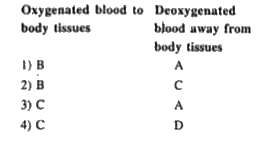In blood, the main buffers are
Na and K
Sodium dihydrogen phosphate and sodium monohydrogen phosphate
Carbonic acid and bicarbonate
Ammonium acetate.
The correct Answer is:C
Step-by-Step Solution:
1. Identify the Buffers in Blood:
The primary buffers in blood are carbonic acid (H2CO3) and bicarbonate (HCO3^-).
2. Understanding Carbonic Acid Formation:
Carbonic acid is formed when carbon dioxide (CO2) dissolves in water (H2O) in the blood. This reaction is crucial for maintaining pH balance.
3. Normal pH Range of Blood:
The normal pH range of blood is between 7.30 and 7.40. This range is essential for proper physiological functions.
4. Effects of pH Disturbance:
- If the pH of blood decreases below 7.30, it leads to a condition known as acidosis.
- If the pH rises above 7.40, it results in alkalosis.
5. Consequences of Acidosis and Alkalosis:
Both acidosis and alkalosis can have severe health implications and may even lead to death if not corrected.
6. Conclusion:
Therefore, the main buffers in blood are carbonic acid (H2CO3) and bicarbonate (HCO3^-).
Final Answer:
The main buffers in blood are carbonic acid (H2CO3) and bicarbonate (HCO3^-).
---
The primary buffers in blood are carbonic acid (H2CO3) and bicarbonate (HCO3^-).
Carbonic acid is formed when carbon dioxide (CO2) dissolves in water (H2O) in the blood. This reaction is crucial for maintaining pH balance.
The normal pH range of blood is between 7.30 and 7.40. This range is essential for proper physiological functions.
- If the pH of blood decreases below 7.30, it leads to a condition known as acidosis.
- If the pH rises above 7.40, it results in alkalosis.
Both acidosis and alkalosis can have severe health implications and may even lead to death if not corrected.
Therefore, the main buffers in blood are carbonic acid (H2CO3) and bicarbonate (HCO3^-).
The main buffers in blood are carbonic acid (H2CO3) and bicarbonate (HCO3^-).
Topper's Solved these Questions
- MOLECULES OF THE CELLBOOK - DINESH PUBLICATION ENGLISHCHAPTER - MOLECULES OF THE CELLEXERCISE - CYG
43 Videos
- MOLECULES OF THE CELLBOOK - DINESH PUBLICATION ENGLISHCHAPTER - MOLECULES OF THE CELLEXERCISE - CYG
43 Videos
- MICROBES IN HUMAN WELFAREBOOK - DINESH PUBLICATION ENGLISHCHAPTER - MICROBES IN HUMAN WELFAREEXERCISE - Brain Teasers-VIII
60 Videos
- MOLLUSCABOOK - DINESH PUBLICATION ENGLISHCHAPTER - MOLLUSCAEXERCISE - CYG
10 Videos
Similar Questions
Two buffer, (X) and (Y) of pH 4.0 and 6.0 respectively are prepared from acid HA and the salt NaA. Both the buffers are 0.50 M in HA. What would be the pH of the solution obtained by mixing equal volumes of the two buffers ? (KHA=1.0×10−5)
View SolutionThe diagram shows the heart with its main blood vessels

Which blood vessels carry oxygenated blood to the body tissues and deoxygenated blood away from the body tissues ?

View SolutionThe pH of blood is 7,4. If the buffer in blood constitute CO2 and HCOΘ3 ions, calculate the ratio of conjugate base of acid (H2CO3) to maintain the pH of blood. Given K1 of H2CO3=4.5×10−7.
View SolutionSTATEMENT-1 : When a small amount of strong acid is added to a buffer solution, its pH value does not change significantly
STATEMENT-2 : Buffer action of the buffer sloution resist the changee in pH when small amount of acid is added to it
View SolutionA buffer solution contains 0.1 mole of sodium acetate dissolved in 1000cm3 of 0.1 M acetic acid. To the above buffer solution, 0.1 mole of sodium acetate is further added and dissolved. The pH of the resulting buffer is :
View SolutionThe most important buffer in the blood consist of :
View SolutionThe buffering action of an acidic buffer is maximum when its pH equals to
View SolutionHigher the amount of acid or base used to produce a definite change of pH in a buffer solution,higher will be its buffer capacity. Buffer capacity of solution is maximum under the following conditions:
[Salt= [Acid] (in acid buffer), [Salt] = [Base] (in base buffer) pH of a buffer solution lies in the range given below: pH = pka±1,
In other words, any buffer solution can be used as buffer up to two pH units only, depending upon the value of pKa, or pKb,. A buffer is said to be efficient when pHa=pKa, or pOH= pkb
Which among the following solution will be the most efficient buffer?
View SolutionWhen 0.1 mole of an acid is added to 2L of a buffer solution, the PH of the buffer decreases by 0.5. The buffer capacity of the solution is
View SolutionHigher the amount of acid or base used to produce a definite change of pH in a buffer solution,higher will be its buffer capacity. Buffer capacity of solution is maximum under the following conditions:
[Salt]= [Acid] (in acid buffer), [Salt] = [Base] (in base buffer) pH of a buffer solution lies in the range given below: pH = pKa±1,
In other words, any buffer solution can be used as buffer up to two pH units only, depending upon the value of pKa, or pKb,. A buffer is said to be efficient when pH=pKa, or pOH= pKb
The bulfer capacity is equal to :
View Solution
